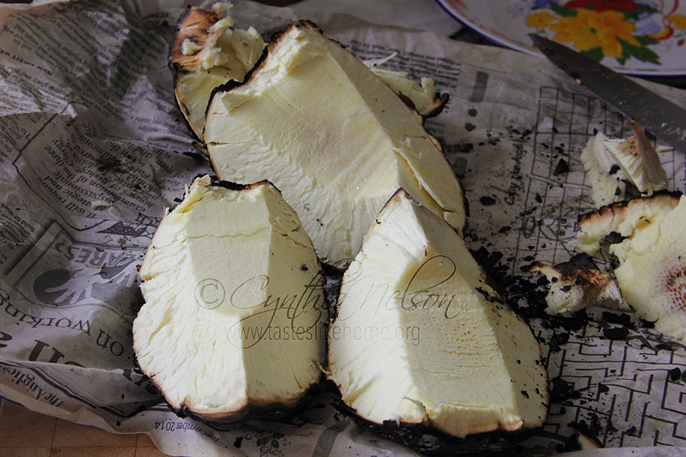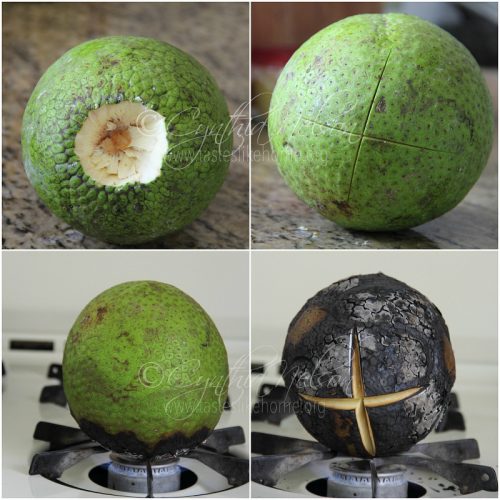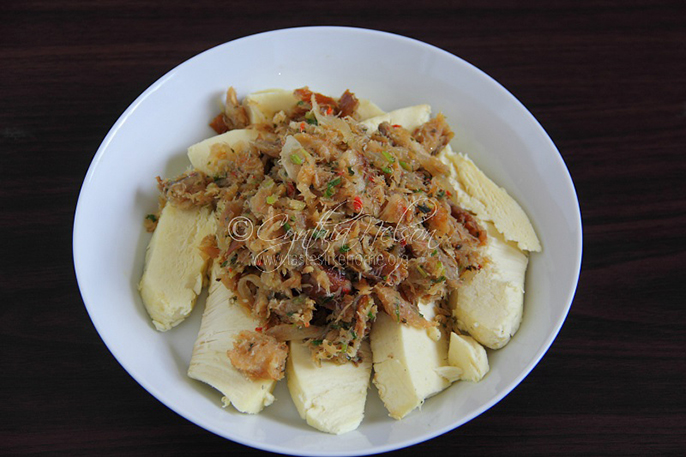Hi Everyone,
This is part two of the five-part series on Tastes Like Home August Holidays.

Aficionados would say that bush-cook style is the best way to roast a breadfruit. It is certainly the fastest way to roast a breadfruit.
My first taste of fire-roasted breadfruit was almost 19 years ago. The building that housed the Caribbean Broadcasting Union (where I worked at the time) was situated on a sprawling plantation that had many types of trees including breadfruit trees. When breadfruit was in season, one of the security guards would roast a few breadfruits out in the yard and share with us when we got to work mid-morning. Hot and soft, with a natural hint of sweetness, and a smoky aroma, the roasted breadfruit would be pried open and shared in large chunks. Let me tell you, it was damn delicious. Yet back then I thought I would rarely get the opportunity to enjoy roast breadfruit – the bush-cook style was just so intimidating.
However, whilst on a trip to Trinidad three years ago, I saw some students of University of the West Indies (UWI, St. Augustine) roasting breadfruit on one of the gas stoves. The breadfruit was sitting on the burner with the flames licking its sides. I noted the action with interest but even then, I did not feel confident enough to try it. My biggest fear being – how to know when the breadfruit is done cooking. It was obvious that even the stovetop roasting required certain know-how of cooking to roast the breadfruit. Back in Barbados, I saw a Vincentian friend with Guyanese roots roast a breadfruit on a small outdoor camping stove (one of those a single burner stoves). I watched carefully and asked questions but got vague responses such as, “You just put it on the fire and let it roast.” I pressed on, “Yes, but how do you know when to turn it and when it is done?” My friend said, “I don’t know, I just know.”
Present day
During the August holidays, breadfruit abounds, perfectly round with a shade of green that puts a spring your step. I was determined that this was the year that I was going to try fire-roasting a breadfruit on my own, in the safety and comfort of my kitchen, on the stovetop.
I bought two breadfruits from one of my old-girl friends at the market. I explained to her what I wanted to do and why I was buying two instead of one breadfruit – in case I don’t get the first one right, I can try again, immediately, with the second one. She handed me my breadfruits and encouraged me, “You can do it”. I had done some research online about roasting breadfruit on the stovetop (you can find how to do almost everything these days on YouTube). I felt nervous but I figured that I had equipped myself as well as I could; coupled with the advice from the video, I would apply my own common sense to the process.
My first attempt was a triumph (I get lucky like this sometimes). Encouraged by the results, I roasted the second breadfruit the next day! Man, I couldn’t wait for the week to end to report to my friend at the market and buy more breadfruit to roast. I was on a roll! So, from the YouTube advice and my own experience, here’s what to do.
■ Roast the breadfruit on high heat.
■ Make four incisions to remove the stem. Think of the breadfruit as having a top – where the stem was, a bottom, and four sides. Wait. I know a breadfruit is round so how can it have four sides? Take a sharp knife and make two cuts at the bottom of the breadfruit that intersect, like a plus sign. The cuts should be no more than an inch deep. Now based on these two cuts at the bottom, you can now determine the four sides of the breadfruit; each cut is a wedge-quarter marking of the breadfruit.
■ The top and bottom of the breadfruit take the longest to cook. The sides take less time, with each side requiring the same amount of time to cook.
■ When the breadfruit is cooked through and done cooking, you will notice smoke-steam escaping from the top where the stem was removed. And, the breadfruit will feel about 50-percent lighter than its original weight.
■ Be very careful when turning the breadfruit because that outer skin hardens and becomes extremely hot like the outer part of hot coals. Therefore, use long tongs or thick oven mitts or kitchen towels to hold the breadfruit.
■ YouTube advised wrapping the roasted breadfruit in three to four layers of very damp (not wet) newspapers and let it sit for 30 minutes before unwrapping and peeling. I did this with the first breadfruit. I thought this was to make the skin soften and easy to peel but it didn’t, or, maybe I got it wrong, so the next day, after roasting, I let the breadfruit rest on a cutting board for about 20 minutes then I cut it open, removed the heart (the middle section) and slid a knife between the flesh and blackened skin which had become a bark, freeing the flesh.
■ The cooking time I am giving you here is an estimate. If your breadfruit has a circumference of 24 to 27 inches, roast the top and bottom for 10 minutes and each of the 4 sides for 8 minutes. If you have a smaller breadfruit say 18 – 20 inches round, cook the top and bottom for 8 minutes and the sides for 6 minutes. However, remember two important things to check for – smoke/steam coming from the top where the stem was removed and the breadfruit being at least half of its weight lighter.
Who among you is planning to roast breadfruit this weekend?
Next week: Fried Eggs
Cynthia








